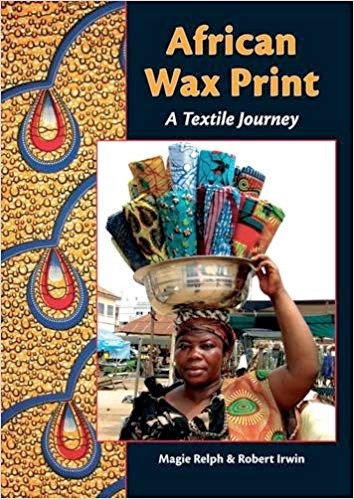Insights on Ghanaian fabrics
We find a variety of fabrics in Ghana, handmade and woven: Mudcloth, Indigo and Kente and printed: Batik (handmade) and Wax (industrially produced).
Mudcloth, Indigo and Kente
These woven cloths are all handmade and locally produced by craftspeople. Every piece is a unique creation. The techniques still put to work today are very old, hundreds of years. The mudcloth is traditionally dyed with fermented mud and has its origins in Mali. The Indigo cloths are produced using natural blue pigments from the plant Indigofera tinctoria. The kente cloths were first produced in the Akan-Ashanti kingdoms and were only worn during festivals and ceremonies. Every colour and pattern has a meaning. Ewe people are creating some of the finest kente today.
Unfortunatly it is very hard to write the history or the sociology of these fabrics because African History is not well documented and there is few documents edited.
Batik and Wax
They are perfect examples of cross-cultural products. The method of resist dyeing has Indonesian origins. The first batiks were certainly introduced by the Dutch in West Africa in the 17th century. The batiks still produced today are handmade and locally produced. Every piece is unique.
At the end of the 19th century many were trying to industrialise the process. The Belgian printer, Jean Baptiste Theodore Previnaire was the most successful. He was working for the Dutch factory called Haarlem Katoen Maatschappij. At the beginning manufacturers were only from Europe: England, Holland, Scottland and Switzerland. The Scottish entrepreneur Brown Fleming was the first one trading those new fabrics with success in Gold Coast (present-day Ghana).
European producers give registration numbers for every design, then West Africans traders (often women) name and give meanings to the motifs. Their meanings might be associated with a proverb and can be used to communicate feelings, teachings, status and even sometimes insults. Wearing some wax or offering them can be seen as a great nonverbal and nonviolent way of communication. They are an expression of West African culture.
Wax prints are expensive to make and require multiple production stages, their designs are clear on both sides. Today only one factory is still in Europe in Holland. The Vlisco products are the only truly Dutch Wax Prints remaining on the market. Vlisco is part of the Vlisco group. Their brands include Woodin, Uniwax and GTP. They have others factories in Africa (for example GTP in Tema, Ghana). From 2010, Actis Group (UK) is the unique shareholder. The headquarters are still in Helmond (Holland).
Africa's Fabric Is Dutch
By Robb Young, 14 November 2012 (New York Times)
https://www.nytimes.com/2012/11/15/fashion/15iht-ffabric15.html
In the middle of the 20th century, the production of wax begun in Africa. And some of the European brands relocated their production on the continent, next to the final consumer. At the end of the 20th century, entered new players in the game, they are from China. The Cha Textiles Group from Hong Kong is the strongest. They bought Akosombo Textiles Ltd (ATL) in 1967 (originally founded by the Ghanaian government in 1964) and the historical brand ABC Wax in 1992. They kept the design studio of ABC in Manchester (UK) but moved the production to Africa in Akosombo (Ghana) in 2005. They produce in Africa and mostly in Asia.
Today, the majority of the products available and sold on the African markets are low-cost reproductions made in China. They are called Hitarget, Fancy print or Imiwax. They don’t use the proper wax-resist techniques to dye the fabric. They only print one side of the fabric. One popular brand is called Phoenix-Hitarget. Most of their design are copies of classic designs or unauthorized copies from brands like Vlisco and ABC and are smuggled in Ghana without paying any taxes. The lower prices make those fabrics more accessible and very popular.
West Africans are ditching Dutch wax prints for Chinese ‘real-fakes’
By Nina Sylvanus, 30 August 2016 (Quartz Africa)
https://qz.com/africa/769792/west-africans-are-ditching-dutch-wax-prints-for-chinese-real-fakes/
The Fabled Cloth and its IP Future
by World Intellectual Property Organization, 2012 (Case Studies - WIPO)
https://www.wipo.int/ipadvantage/en/details.jsp?id=3501
The only African owned company I can name is Printex. They are a family-owned mill manufacturing in Accra and selling all over Africa.
We can try to know the origin of a fabric by reading the details printed on the selvage and on the labels sticked to the fabric.
Some authors made a point to prove that the term ‘African print’ is a misnomer for the wax print.
The “African Print” Hoax: Machine Produced Textiles Jeopardize African Print Authenticity
by Tunde M. Akinwumi, July 2008 (The Journal of Pan African Studies, vol.2, no.5)
http://www.jpanafrican.org/docs/vol2no5/2.5_African_Print.pdf
And others keep saying, it’s a complicated story…
The Fraught History Of African Textiles
by Meg Miller, 4 March 2017 (Fast Company)
https://www.fastcompany.com/90108110/the-fraught-history-of-african-textile
Movies
Books
First published in December 2018
Updated in May 2019














